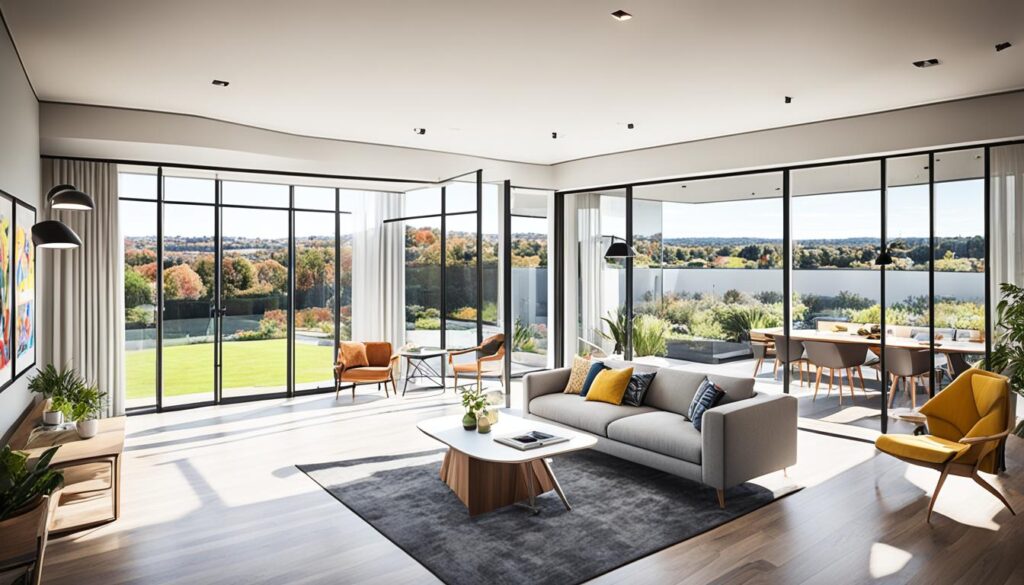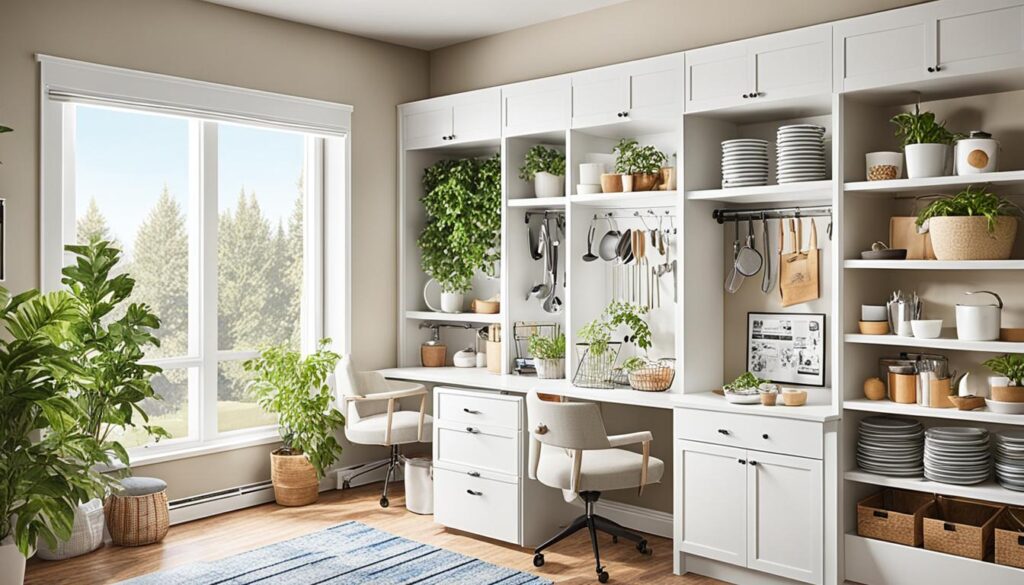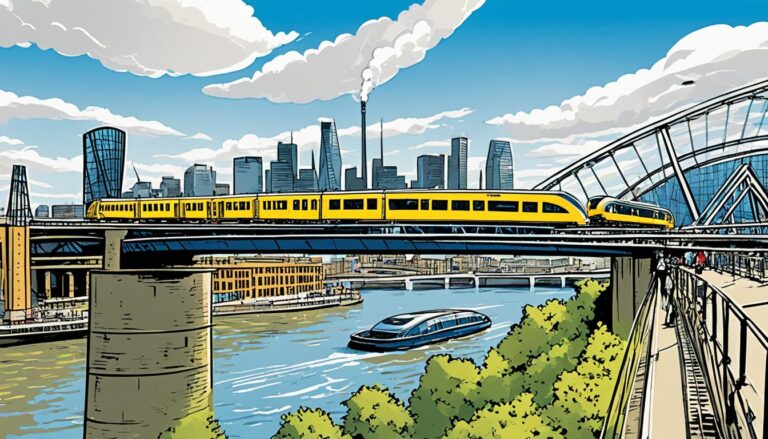Retirement House Plans: Design Your Golden Years Home
Did you know that over 10,000 baby boomers reach retirement age every day in the United States? This shows the growing need for well-designed retirement homes.
Your retirement should be a time of comfort and peace. That’s why retirement house plans are important. They help you build or renovate a home that fits your needs as you age.
Key Takeaways:
- 10,000 baby boomers reach retirement age every day in the United States.
- Retirement house plans are in high demand as the population continues to age.
- Well-designed retirement homes offer comfort, accessibility, and peace of mind.
- Thoughtful design is crucial to meet changing needs as you age.
- Whether building from scratch or renovating, retirement house plans are essential.
Key Considerations for Retirement House Plans
When designing your retirement home, think about what elderly residents need. The plans should offer comfort, convenience, and focus on accessibility and functionality. Whether you’re building new or updating an old home, remember these important points:
1. Accessibility
Make sure your retirement home is easy to get around in, even for those with mobility issues. Wide doors, ramps, and grab bars in bathrooms help with staying independent. Also, place light switches and outlets where they’re easy to reach.
2. Convenience
Retirement homes should make everyday tasks easier. Think about single-floor living, open layouts, and lots of storage to cut down on bending or climbing. Kitchens and bathrooms should be easy to use with adjustable counters and fixtures.
3. Functionality
Functional floor plans are crucial for retirement homes. They make sure spaces are used well and meet the elderly’s needs. Include rooms that can change use and lots of natural light and air to keep the living area comfortable.
By focusing on accessibility, convenience, and functionality, you can make a home that supports independence and a good quality of life for the elderly.
Designing for Aging in Place
Retirement house plans should focus on aging in place. As we age, our mobility and physical abilities change. It’s key to design homes that meet the needs of older people. Using universal design principles makes a retirement home safe and comfy for seniors to live independently.
Key to designing for aging in place is making the home easy to move around in. This means wider hallways, ramps, and single-floor living to avoid stairs. These changes make the home accessible and give seniors more freedom and ease.
It’s also vital to focus on safety in the home. Grab bars in bathrooms, non-slip floors, and bright paths can lower the chance of falls. Smart home tech can also boost safety by allowing remote control of house systems.
Designing a home for the elderly means thinking about comfort and ease. Open floor plans help seniors move around easily and socialize. Plus, lots of natural light, comfy seating, and adjustable features like countertops make the home more livable.
“Designing for aging in place means prioritizing the needs and well-being of retirees, creating a harmonious living space that supports their independence and comfort.” – Jane Smith, Architect
| Features | Description |
|---|---|
| Wider hallways and doorways | Allow for easier navigation and wheelchair accessibility. |
| Ramps or no-step entrances | Eliminate the need for stairs, providing a barrier-free entry. |
| Grab bars | Installed in bathrooms to provide stability and prevent slips. |
| Non-slip flooring | Reduces the risk of accidents, especially in high-risk areas. |
| Smart home technology | Allows for remote monitoring and control of various systems. |
Designing for aging in place means making a home safe and functional. It also means adding things that make seniors happy and comfortable. By focusing on their needs, retirees can enjoy their golden years with confidence and peace of mind.
Creating a Relaxing Retreat with Outdoor Spaces
Outdoor spaces are key in retirement home designs. They make life better for retirees. Places like tranquil gardens and inviting patios offer a chance to relax and enjoy nature’s beauty.
It’s important to blend outdoor spaces with indoor living areas in retirement community floor plans. These areas can help people socialize, stay active, and find peace. Here are some ideas for making outdoor spaces in retirement homes calm and welcoming:
1. Zen-inspired Gardens
A Zen-inspired garden can make retirement homes peaceful and harmonious. Use flowing water, rocks, and greenery to create calmness. Add seats or spots for meditation to let residents enjoy the peacefulness fully.
2. Cozy Patio Spaces
A great patio is perfect for retirees to unwind, read, or sip coffee. Think about adding comfy furniture, shade, and plants for a cozy feel. These spots can be big or small, fitting each resident’s taste and needs.
3. Serene Water Features
Water features like ponds or fountains add calmness to outdoor areas. The sound of water can make people feel relaxed and focused. These features look nice and create a soothing sound that makes the retirement home feel better.
4. Walking Paths and Trails
Adding walking paths and trails is good for staying active and exploring outside. These can go through pretty gardens or nature, offering walks that are easy or challenging. Everyone can enjoy these paths, no matter their fitness level.
With good planning and design, retirement homes can have outdoor spaces that are peaceful and welcoming. Whether it’s a quiet garden, a cozy patio, or a calm water feature, these areas make retirement living better.
Next, we’ll look at floor plans that make living in retirement homes easy. Stay tuned!
Functional Floor Plans for Easy Living
Creating retirement house plans means focusing on functional floor plans. These plans make it easy for seniors to move around, reduce strain, and support independent living. They are designed with senior living and elderly-friendly features in mind.
Key to a good floor plan is using space well and making it easy to get around. Open layouts and wide hallways help seniors move without trouble. They also include non-slip floors, grab bars, and lever handles for safety and ease.
Ranch-style floor plans are popular for retirees. They have only one story, so there are no stairs or elevators. This makes it safe for seniors to move around. Important rooms like bedrooms, bathrooms, and the kitchen are all on the main floor.
These floor plans also support aging in place. This means seniors can live in their own homes as they get older without needing help. They have wider doorways for walkers, good lighting, and lots of storage to keep things tidy.
Multi-purpose spaces are another key feature. They can be guest rooms, offices, or hobby areas. This lets seniors change their living space to fit their needs over time.

Incorporating Technology for Convenience
Technology is important in making living easy. Smart home features like automated lights and cameras can be added. These make life easier, safer, and more energy-efficient.
Retirement house plans focus on what seniors need for a comfortable life. They consider the layout, accessibility, and flexible spaces. This way, retirees can easily move around and stay independent in their homes.
Essential Features for Aging in Place
When designing retirement homes, focus on safety, comfort, and accessibility. It’s important to include features that meet the needs of aging people. This makes the house not just beautiful but also supports their health and independence. Let’s look at some key elements to think about:
Well-lit Spaces
Seniors need good lighting to see well and avoid falls. Use big windows and skylights to bring in natural light. Also, add task lights and motion-sensor lights in important areas like corridors and staircases.
Wide Doorways and Hallways
Make sure doorways and hallways are wide enough for walkers or wheelchairs. A minimum of 36 inches wide makes moving around the home easier.
Grab Bars and Handrails
Grab bars and handrails give seniors support and stability. Put them near showers, toilets, and stairs to lower the chance of accidents and boost confidence.
Non-Slip Flooring
Use flooring that doesn’t slip to reduce fall risks. Non-slip tiles, textured vinyl, or cork flooring are good choices for busy areas like bathrooms and kitchens.
Accessible Bathroom Features
Make bathrooms safe and easy to use for seniors. Add walk-in showers with grab bars, adjustable showerheads, and benches. Also, consider a raised toilet seat and a vanity with knee space for accessibility.
Kitchen Adaptations
Kitchens should be easy to move around in and use. Use appliances with clear controls and countertops and cabinets at different heights. Make sure there’s enough room for wheelchair access.
Planning a retirement home with these features in mind makes it safe, comfy, and functional. By adding these elements, you can help create a great place for a happy retirement.
Embracing Technology for a Smart Retirement Home
Today, technology is a big part of our lives. It’s also key in retirement home designs and plans. Adding smart tech makes life easier and safer for seniors. It makes their homes more comfortable and secure.
Home automation is a big win for retirees. With smart devices, they can control things like lights and security with ease. This means they can relax with the right lighting or check on their home from anywhere.
Enhancing Safety and Security
Seniors worry about safety and security. Smart tech helps with this. For example, smart locks make getting into the home easy without keys. Smart security systems add extra protection with cameras and alarms.

“Incorporating smart technology into retirement house plans enables seniors to enjoy an independent lifestyle while having peace of mind.”
Promoting Convenience and Comfort
Retirement is for relaxing and enjoying life’s simple pleasures. Smart tech makes everyday tasks simpler. Voice assistants help with schedules and calls, and automated shades adjust the light for comfort.
Fostering Independence
Keeping independence is key as we age. Smart tech helps seniors stay independent. Systems track activities and send alerts if something’s off. Reminders for medication make sure they take their pills.
The Future of Retirement Home Designs
Technology keeps getting better, so will retirement homes. We’ll see more advanced health monitoring and virtual reality for mental health. By using tech, retirement homes can meet seniors’ needs better, improving their health and happiness.
| Benefits of Smart Technology in Retirement Homes | Examples |
|---|---|
| Enhanced safety and security | Smart locks, security cameras, motion sensors |
| Convenience and comfort | Voice-controlled assistants, automated window coverings |
| Promotion of independence | Smart home monitoring, medication reminders |
Incorporating Health and Wellness Spaces
When designing retirement house plans, it’s key to focus on the health and well-being of future residents. Adding spaces like home gyms, spa-like bathrooms, and meditation areas makes a place supportive of an active life. This helps create an environment that supports a balanced lifestyle.
Retirement house plans should have a spot for exercise and fitness. A home gym lets seniors stay fit without leaving home. It could be a small corner or a big room, but it should be easy to get to. This encourages regular exercise and keeps seniors healthy.
Senior living home plans also benefit from spa-like bathrooms. These bathrooms have walk-in showers, grab bars, and non-slip floors for safety. Adding things like whirlpool tubs or steam showers can help with muscle pain and relaxation.
Adding meditation areas in retirement homes gives seniors a quiet spot for mindfulness. These areas have comfy seating, soft lights, and nature elements for calmness. They offer a place for seniors to relax, lower stress, and boost their mental health.
These health and wellness spaces make retirement homes better for residents. They help with physical, mental, and emotional health. By focusing on seniors’ needs, retirement homes can make their later years fulfilling and happy.
Maximizing Storage and Organization
When designing retirement homes, it’s important to focus on storage and organization. Retirees often downsize or declutter, making smart storage solutions key. This ensures a functional and cozy living space.
Retirement home designs focus on the needs of seniors. They offer smart storage solutions that use space well without losing style. Built-in closets, cabinets, and shelving make every inch count. Furniture like ottomans or bedframes with drawers also helps reduce clutter.
Senior living home plans think about what retirees need for storage. They include easy-to-reach shelves, spacious walk-in closets, and adjustable shelving. These features help keep everyday items close and easy to get to, supporting independence and safety.

Good retirement house plans also focus on each room’s purpose. Kitchens get pull-out shelves and custom drawer inserts to save space. Bathrooms have wall-mounted cabinets and grab bars with hidden storage, keeping things tidy and safe.
Having a spot for hobbies and crafts is vital in retirement homes. A sewing room, workshop, or home office needs storage like labeled bins and adjustable shelving. This keeps supplies organized and easy to find.
Storage and Organization Tips for Retirees:
- Maximize closet space by using double-hanging rods and adjustable shelving systems.
- Utilize under-bed storage containers or bed frames with integrated drawers.
- Install ceiling-mounted racks in the garage for storing bulky items.
- Utilize wall-mounted hooks and baskets to keep frequently used items within reach.
- Consider installing a walk-in pantry with well-organized shelves and pull-out drawers.
In conclusion, making retirement homes efficient in storage and organization is key. By focusing on smart storage and organization, retirees can live in a clutter-free space. This brings comfort, accessibility, and peace of mind.
Energy Efficiency and Sustainable Living
When planning your retirement home, think about energy efficiency and sustainable living. These ideas help the environment and can make your life better and cheaper. Using energy-saving features and green materials makes your home cozy and good for the planet.
Energy-efficient designs cut down on utility bills. Choosing plans that focus on saving energy can lower your monthly bills. This is great for retirees living on a fixed income. Plus, these homes often sell for more, making them a smart choice for the future.
Retirement communities can also support sustainable living. They might have gardens, solar panels, and systems to collect rainwater. These features lessen environmental harm and help residents connect with each other.
Choosing green building materials is key. Using bamboo flooring, recycled glass countertops, and paints with no harmful fumes makes your home healthier. It also helps the planet. These choices are good for your health and the earth.
When designing your retirement home, think about what older people need. Add features like energy-saving lights, smart thermostats, and good insulation. These make your home more comfortable and use less energy. Also, using natural light and ventilation makes your home bright and healthy.
By focusing on energy efficiency and sustainable living, you can make a retirement home that looks good and is good for you and the earth. Whether you’re building new or updating, these ideas will make your home comfortable, green, and enjoyable for years.
Customizing Your Retirement House Plans
Designing your perfect retirement home means making it your own. Your retirement house plans should match your style, lifestyle, and the rules of your community. You might want a cozy cottage, a modern city home, or a big suburban house. Customizing lets you make a home that fits your needs perfectly.
Customizing your home means adding features that make life easier and safer as you age. Think about wider doors, no-step entries, and grab bars in the bathroom. This way, your home will be great now and later, even if you need more help moving around.
Designing for Aging in Place
Thinking about aging in place means designing your home for the future. You can add features like open floor plans, single-story layouts, and smart technology. These make life easier and more convenient as you get older.
Customizing your home also means making the outdoors special. You might want a private patio, a garden, or a porch for watching the sunset. It’s all about making your outdoor space your own.
Adding technology is another way to make your retirement home better. With smart home systems, you can control things like the climate, lights, and security easily. This makes life simpler and helps save energy.
| Retirement House Plans | Senior Living Home Plans | Retirement Home Designs |
|---|---|---|
| Customization | Promote independence and convenience | Embrace technology |
| Aging in place design | Outdoor spaces tailored to preferences | Smart home integration |
By customizing your retirement home, you get a place that reflects your vision and supports your lifestyle. It becomes a safe and comfortable space for enjoying your retirement.
Working with Architects and Home Builders
When you want to make your retirement house plans come true, working with experts is key. Architects and home builders with experience can make your dream home a reality. Here are steps to follow when working with these professionals:
1. Research and Select the Right Team
Start by looking for architects and builders who focus on retirement homes. Check their portfolios for elderly-friendly designs. Ask friends, family, or local people for advice. Also, read reviews to learn about their past work.
2. Define Your Needs and Preferences
Before talking to architects and builders, list what you need for your retirement home. Think about accessibility, the layout, and special features for aging in place. This will help the professionals understand what you want for your home.
3. Consultation and Design Phase
Talk about your ideas with architects and builders during the first meeting. Share your goals and what you like. They will use their skills to make plans that fit your vision and follow the rules. This might mean making changes and working together to get the design right.
4. Evaluating Builders and Obtaining Bids
With your plans ready, pick a builder to make it happen. Look at their experience, reputation, and if they can finish on time and within budget. Ask for bids from several builders and check them against your design, timeline, and budget.
5. Construction and Project Management
Keep in touch with the builder and architect during construction. Talk about any problems that come up. Good management means your retirement home is built right, and any issues are fixed quickly.
6. Final Inspection and Handover
Do a final check of the home with the builder and architect once it’s done. Make sure everything matches the plans and fix any last things before you move in. This ensures your retirement home is perfect for you.
7. Ongoing Communication and Support
Keep in touch with the architect and builder after you move in. This helps with any problems or changes you might need later. Talking with experts who know your home can give you support as you settle into retirement.
Working with architects and builders who know about retirement homes gives you the help and advice you need. Together, you can create a home that suits your needs and preferences. This will make your retirement beautiful and functional.
Table of Contents
- Retirement House Plans: Design Your Golden Years Home
- Key Considerations for Retirement House Plans
- Designing for Aging in Place
- Creating a Relaxing Retreat with Outdoor Spaces
- Functional Floor Plans for Easy Living
- Essential Features for Aging in Place
- Embracing Technology for a Smart Retirement Home
- Incorporating Health and Wellness Spaces
- Maximizing Storage and Organization
- Energy Efficiency and Sustainable Living
- Customizing Your Retirement House Plans
- Working with Architects and Home Builders
- Conclusion
Conclusion
Designing your retirement home is crucial. Think about making it easy to move around, useful for daily tasks, and true to your style. This way, you’ll have a home that makes your golden years comfortable and fun.
Choosing the right design features and custom options is important. It lets you live the retirement life you’ve always wanted. So, make sure to plan well and think about what you really need and like.
By focusing on accessibility, functionality, and your personal style, you can create a home that suits you perfectly. This ensures you can enjoy your retirement to the fullest.





